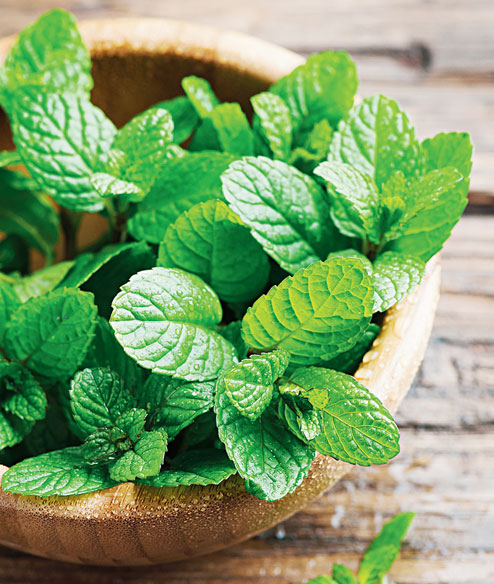
In Greece and Italy, people welcome their guests by rubbing Mint leaves on table tops. Not only is the aroma pleasant but it also kept away insects.
Jews spread Mint leaves on the floor of their synagogues to keep their sacred place pest-free.
In India, particularly in the northern regions, Mint is called Pudina and is best known for adding flavour to dishes like Pudina Paratha and Pudina Pakoras, and drinks.
There are many varieties of Mint and all of them are hard perennial. The plants belong to the genus Mentha and family Lamiacea. The common mint is an erect branched herb reaches a height of 60cm. Leaves are generally 5cm long with small leafstalk and leaf margins toothed. Its small flowers are purple, pink or white and come in whorls or terminal spikes. They appear mostly in summer.
Climate and soil — Mint can be grown in almost all climates as it is indigenous to many countries and continents. It will even grow in arid areas if provided with a regular supply of water, but best would be a site that is shaded for the part of the day.
The soil should be moderately rich and well mulched so that it retains moisture. Mint beds should be free from perennial weeds.

Growing method - Mint has an invasive habit which can be troublesome. This can be controlled by growing the herbs in large clay pots, old buckets or heavy-duty plastic bags sunk to their rims in the ground or in narrow beds often found in the foot of a wall where the exuberant growth can be controlled more readily.
Propagation is done by cutting or root division during spring and late summer. The latter is a more popular method. Mint plants may be dug from established beds in late summer and transplanted elsewhere. They must be kept well-watered in dry weather until they take hold.
It is customary to renew Mint beds every three years. In case of containers, lift and divide the plant each spring and replant young vigorous pieces in the container using fresh compost. No further fertilisation will be necessary if planted in well-mulched soil.
Harvesting and storing- Mint shoots, for drying and storing, should be picked on a dry sunny day. Frequent pruning of the stems forces lateral branching and healthier plants. The younger the leaf, the more tender and tasty it will be.
Leaves can be dried by placing in a rack in a cool, airy space. When they dry, crumble them and store in air-tight jars. Fresh leaves can be chopped and frozen in small packages.
Uses- Mints have a wide range of flavours from the fruity taste of Apple Mint to the perfume-like ones of the eau-de-cologne varieties.
Dried Mints can be used in soups. Mint Chutney refreshes both the tongue and the breath. This cooling herb is used in most cuisines around the world from stuffing and starters to fruit salads and cocktails.
In Indian cuisines Mint typically features in raitas, parathas and chutnies and when traditional English dishes like Roast Lamb become heavy and stodgy, Mint Sauce or Mint Jelly is served alongside to help digestion.
Besides indigestion, Mint is also useful in curing body pain, vomiting, fever, headaches, rheumatic pains etc.
Amongst various species in the Mentha group the most important is Pepermint (Mentha piperita). The main use of this plant is for extraction of oil and is largely used in medicines.
Its leaves are used in making tea, syrups and desserts. Spear Mint (Mentha spicata) is another important Mint and its oil is useful in dentifrice, confectionery and pharmaceutical products. The aromatic cool product of the Japanese Mint (Mentha arvensis) is peppermint camphor. There are other varieties like Lemon Mint and Apple Mint too. The Mentha is one of the highest revenue earning products for our farmers.
• To be continued
MINT MOCKTAIL

Ingredients:
Fresh mint leaves - 40g
Honey - 2tbsp
Lemon- The juice of 1 lemon
Rock salt - 1 tsp
Soda - 2 bottles
Water - ½ glass
Ice cubes - as required
Method:
Add the mint leaves, honey, lemon juice, water, ice cubes and rock salt in a blender. Strain and pour in the soda. Serve chilled with a mint leaf on the glass for garnish.
Reader’s question
Q. Can the Coriander seeds we use in cooking be used to plant new coriander plants? I plan to cultivate some in pots at home.
Tapan Chakraborty, Address not given

A. There are two types of Coriander seeds. One would produce the best leaves to be consumed as dhone pata and the other is best used as a spice. If you use the seeds available at home you cannot be sure which variety it is.
There is also a catch in buying Coriander seeds from the nursery as most workers there are not aware of the difference. So it is best to buy them from a dedicated seed shop such as the ones available at Baithak Khana Bazar.
What are your gardening-related queries?
Write to The Telegraph Salt Lake, 6, Prafulla Sarkar Street, Calcutta 700001.
Email: saltlake@abpmail.com










